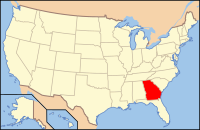Echols County, Georgia
| Echols County, Georgia | |
|---|---|

Echols County Courthouse in Statenville
|
|
 Location in the U.S. state of Georgia |
|
 Georgia's location in the U.S. |
|
| Founded | December 13, 1858 |
| Named for | Robert Milner Echols |
| Seat | Statenville |
| Largest community | Statenville |
| Area | |
| • Total | 421 sq mi (1,090 km2) |
| • Land | 415 sq mi (1,075 km2) |
| • Water | 5.8 sq mi (15 km2), 1.4% |
| Population | |
| • (2010) | 4,034 |
| • Density | 10/sq mi (4/km²) |
| Congressional district | 1st |
| Time zone | Eastern: UTC-5/-4 |
| Website | echolscountyga |
Echols County /ˈɛkʊz/ is a county located in the U.S. state of Georgia. As of the 2010 census, the population was 4,034. The county seat is Statenville. Statenville is a disincorporated municipality. Echols and Webster County are the only two counties in Georgia to currently have no incorporated municipalities. The county was established in 1858 and named in honor of Robert Milner Echols (1798–1847).
Echols County is part of the Valdosta, GA Metropolitan Statistical Area.
Echols County has become notable in recent years as it has served as a place of banishment for many of Georgia's criminals. As the Georgia State Constitution forbids banishment beyond the borders of the state, officials instead ban the offender from 158 of Georgia's 159 counties, with Echols remaining as their only option. Few criminals have been documented as actually moving to Echols. This is because almost all banished criminals choose to leave the state instead of move to Echols County.
Banishment, including 158 county banishment, has repeatedly been upheld by Georgia courts. The first case when banishment was upheld was in the 1974 case State v Collett, when the Ga Supreme Court upheld the banishment of a drug dealer from seven counties. The most recent time banishment was upheld, in 2011, the Ga Supreme Court ruled it was constitutional to banish David Nathan Thompson (a mentally ill man who was convicted of firing a gun into a home, although nobody was injured) from all but one county in Georgia.
On December 13, 1858, the Georgia General Assembly passed a bill establishing Echols County from a south-eastern section of Lowndes County and a south-western section Clinch County. The original borders of the county were a line from the mouth of the Suwanoochee Creek directly south to the state line, then along the state line, then north to the junction of Grand Bay Creek and Mud Swamp, then up the course of Grand Bay Creek to Carter's Ford, then a direct line to where Cow's Creek enters the Alapaha River, then up the creek to Griffins' Mill, then a direct line to Jack's Fort on Suwanoochee Creek, and then down Suwanoochee Creek to its mouth. With the exception of some minor adjustments of the border Echols shares with Lowndes and the loss of a thin strip to Florida following Florida v. Georgia, the borders of Echols County has changed little since its establishment. Statenville was declared the county seat in 1859.
...
Wikipedia
